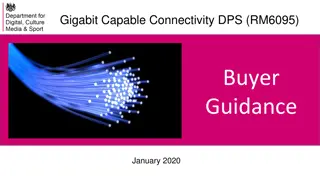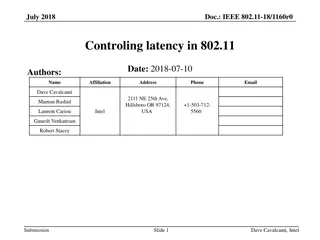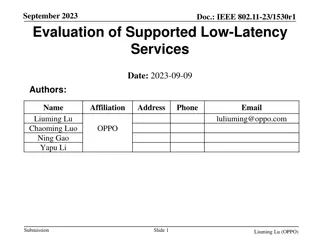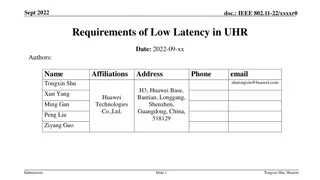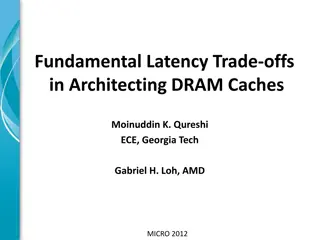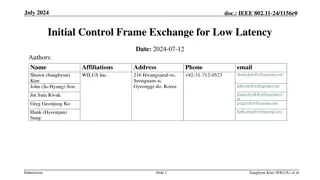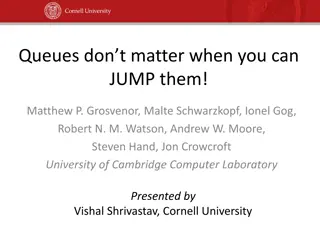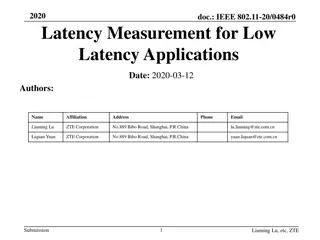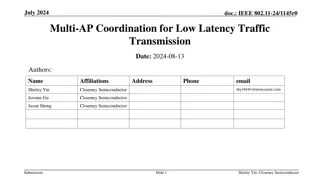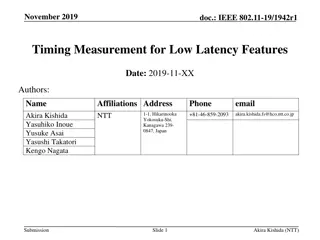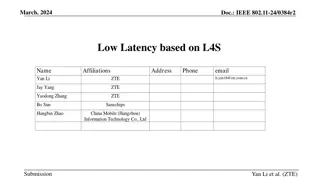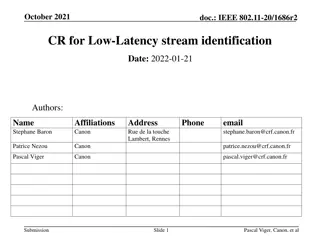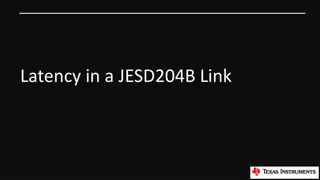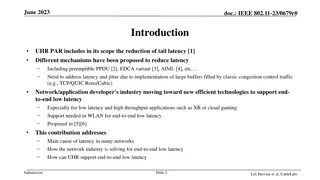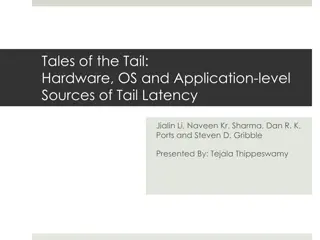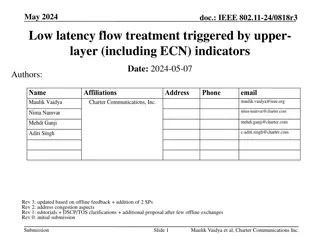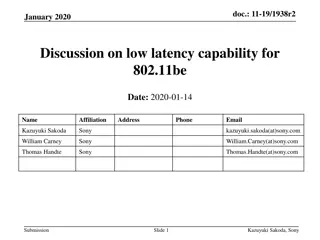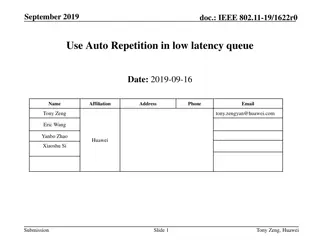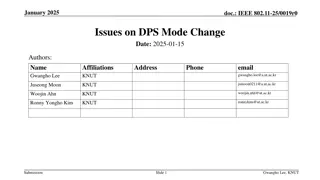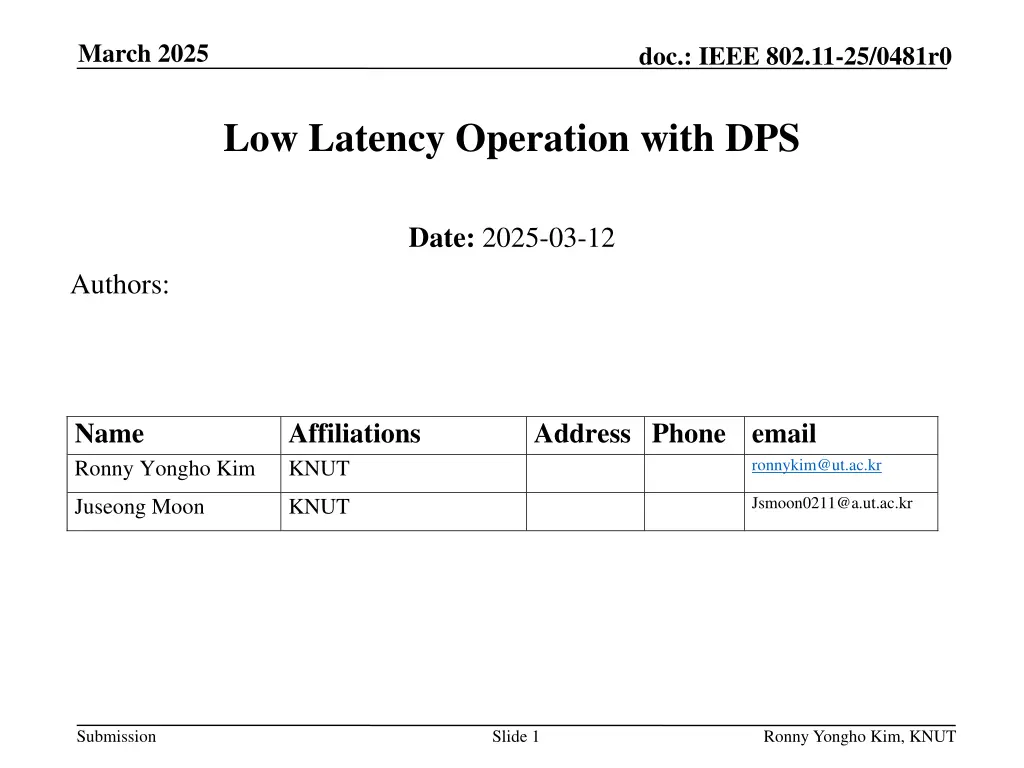
Wireless Communication Efficiency
Discover how IEEE 802.11-25/0481r0 proposes low-latency operations with dynamic power-saving methods, focusing on R-TWT support for low-latency traffic. The document discusses autonomous DPS mode changes, enhancing power-saving gains for periodic low-latency traffic support. Explore the implementation of DPS modes, ICF and ICR exchanges, and the importance of HCM and LCM for efficient wireless communication.
Download Presentation

Please find below an Image/Link to download the presentation.
The content on the website is provided AS IS for your information and personal use only. It may not be sold, licensed, or shared on other websites without obtaining consent from the author. If you encounter any issues during the download, it is possible that the publisher has removed the file from their server.
You are allowed to download the files provided on this website for personal or commercial use, subject to the condition that they are used lawfully. All files are the property of their respective owners.
The content on the website is provided AS IS for your information and personal use only. It may not be sold, licensed, or shared on other websites without obtaining consent from the author.
E N D
Presentation Transcript
March 2025 doc.: IEEE 802.11-25/0481r0 Low Latency Operation with DPS Date: 2025-03-12 Authors: Name Ronny Yongho Kim Affiliations KNUT Address Phone email ronnykim@ut.ac.kr Jsmoon0211@a.ut.ac.kr Juseong Moon KNUT Submission Slide 1 Ronny Yongho Kim, KNUT
March 2025 doc.: IEEE 802.11-25/0481r0 Abstract TGbn agreed Dynamic Power Saving (DPS) method DPS mode can be changed with ICF and ICR exchange. Lower capability mode (LCM) and higher capability mode (HCM) can be enabled with ICF and ICR exchange. R-TWT was adopted in 11be for low latency traffic support. In order to support low latency traffic during R-TWT SP, both AP and STAs should be in HCM. When either an AP or a STA in LCM, ICF and ICR exchange shall be performed before R-TWT SP. After R-TWT SP, ICF and ICR exchange is required to change DPS mode into LCM. In this contribution, autonomous DPS mode change is discussed. Submission Slide 2 Ronny Yongho Kim, KNUT
March 2025 doc.: IEEE 802.11-25/0481r0 R-TWT with DPS In order to support low latency traffic during R-TWT SP, both AP and STAs should be in HCM. When either an AP or a STA in LCM, ICF and ICR exchange shall be performed before R- TWT SP. After R-TWT SP, ICF and ICR exchange is required to change DPS mode into LCM. Comm. with STA1 Comm. with STA1 SCS Rsp ICR ICR ICR ICR DPS STA (AP) Beacon SCS Req ICF ICF ICF ICF STA 1 (LL) STAs Low Capability High Capability Low Capability High Capability Low Capability Submission Slide 3 Ronny Yongho Kim, KNUT
March 2025 doc.: IEEE 802.11-25/0481r0 R-TWT and Autonomous DPS mode change When R-TWT is setup, DPS mode can be autonomously changed before R-TWT SP and after R-TWT SP. DPS mode can be autonomously change into HCM before R-TWT SP. DPS mode can be autonomously change into LCM after R-TWT SP. With autonomous DPS mode change for periodic low latency traffic support, additional power saving gain can be achieved. DPS Announcement reduced BW/NSS/MCS Period DPS Announcement reduced BW/NSS/MCS Period Comm. with STA1 Comm. with STA1 SCS Rsp DPS STA (AP) Beacon Comm. with other STAs Beacon Comm. with other STAs SCS Req Low Capability High Capability Low Capability Low Capability High Capability Low Capability STA 1 (LL) STAs Submission Slide 4 Ronny Yongho Kim, KNUT
March 2025 doc.: IEEE 802.11-25/0481r0 R-TWT and Autonomous DPS mode change R-TWT SP with UL traffic R-TWT SP SCS LL Data (Downlink) respons e Beacon BA AP 1 Non-DPS DPS Lower Capability DPS Higher Capability DPS Lower Capability SCS request LL Data (Uplink) BA STA 1 R-TWT SP with DL traffic R-TWT SP SCS LL Data / TF (Downlink) respons e Beacon BA AP 1 Non-DPS DPS Lower Capability DPS Higher Capability DPS Lower Capability SCS request LL Data (Uplink) BA STA 1 Submission Slide 5 Ronny Yongho Kim, KNUT
March 2025 doc.: IEEE 802.11-25/0481r0 Summary This submission proposed autonomous DPS mode change for R-TWT DPS mode can be autonomously change into HCM before R-TWT SP. DPS mode can be autonomously change into LCM after R-TWT SP. With autonomous DPS mode change for periodic low latency traffic support, additional power saving gain can be achieved. Submission Slide 6 Ronny Yongho Kim, KNUT

